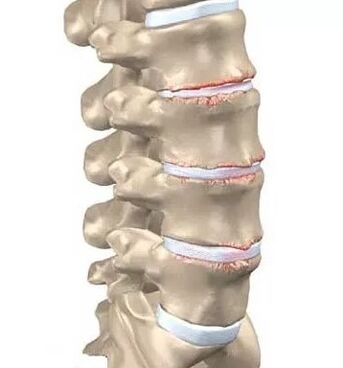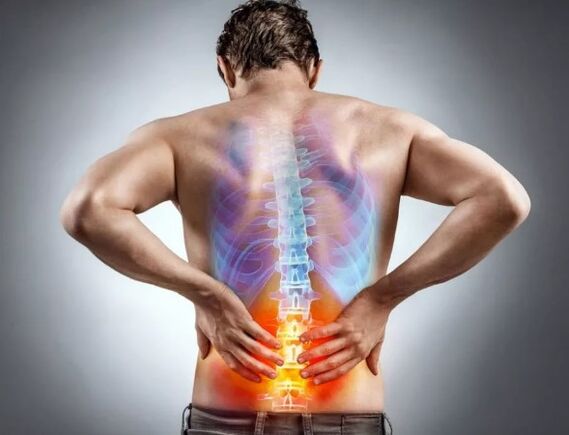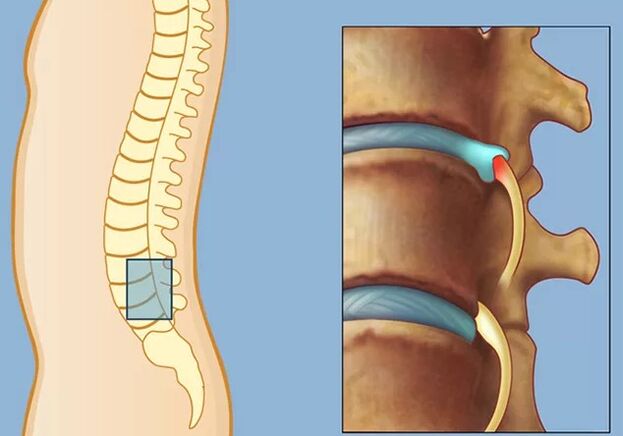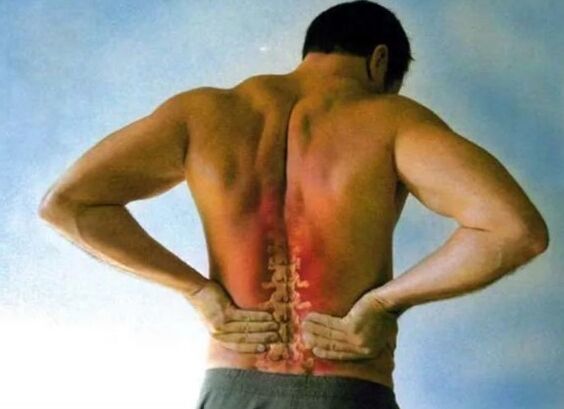Osteochondrosis of the lumbar spine is a disease that is a special form of damage to the spine. Patients with such a disease complain of rapid fatigue, back pain, legs, causing a limitation of motor activity. In osteochondrosis, there is deformity of the intervertebral discs, there is a decrease in their height, dystrophy and coerco growth of the vertebrae. When diagnosing radiography, the dyskhones are clearly visible.

Deformation of cartilage tissue during the development of osteochondrosis is a complex process, including biochemical and vascular changes. First, the fibrous ring is destroyed, resulting in a Pulpos into it. As a result, the fibrous ring is torn and the hernia of the disc is formed. In this case, the segment with a lower gloss and a lower lover is subjected to the highest load. The hernia of the disc, squeezing the spinal cord or its roots, becomes a cause of back pain that reacts in the legs.
The most powerful seat nerve in the human body is formed by sacral roots of the spinal cord. They, as well as the lower lover, are irritated by osteochondrosis. The second name of the disease is formed by the Latin name of the sciatic nerve - sciatica.
Due to the disturbance of the structure of cartilage tissue, the intervertebral discs, which are special cartilage structures, can no longer fulfill all their functions completely. This leads to loss of flexibility and mobility of the spine. The processes, which in the initial stages of the disease affect only intervertebral discs, are gradually applied to the vertebrae themselves.
Disogenic radicolitis, which is considered one of the most common symptoms of osteochondrosis, is found in almost every fifth person more than 30 in the world. At risk, people of working age are most often at risk. Osteochondrosis deprives the ability to engage in active activity and often causes damage.
Symptoms of lumbar osteochondrosis
The main symptoms of lumbar osteochondrosis are severe back pain. In addition to this sign, however, there are a number of others. So, patients suffering from this disease are quickly tired, complaining about headaches, fatigue and irritability. Rear discomfort does not allow you to choose a comfortable sleep position so that the body cannot relax completely and restore after the end of the day. The loss of force forces the patient to minimize physical activity and to avoid pain. This leads to the fact that over time it is not capable of even simple actions, for example, to ensure its own household needs.

Problems in the functioning of the genotor system can also be one of the symptoms of lumbar osteochondrosis. They appear in the form of pain in the kidney area. In patients with osteochondrosis, urination is impaired, the unexpected onset of seamless discomfort is possible. This leads to the instability of the vertebrae, which, due to deformation, are not fixed by intervertebral discs. The load on the spine provokes the displacement of the lumbar department from the sacrum when the weight of the force is exposed to it. Such a process leads to damage to the internal organs, problems in their work. In women, ovaries, appendages and uterus most often suffer, and potency is disturbed in men.
Osteochondrosis is characterized by an increase in the sensitivity of the legs, including stop, hips and lower legs. They are cramps that can lead to a complete loss of pulse. The skin of the patient with osteochondrosis of the legs is very dry, peeled and covered with geese in the area of discomfort. During attacks of pain, sweating is impaired.
All symptoms of osteochondrosis can be classified into the following groups:
Rook syndrome
The thinning of the intervertebral discs leads to a loss of stability of the vertebrae. Once they become mobile, they begin to irritate and squeeze blood vessels and nerve roots with sharp movements and heavy physical activity. This process minimizes the pain in the lumbar region, but they resume with renewed energy where the nerve is compressed. The pain is acute and breaks. The most discomfort is expressed in the lower leg, thigh, legs and ass. The unpleasant sensations cause the patient to change the gait, leaning into the opposite side of the nerve.
When the nerve roots are irritated for a long time, their inflammation, swelling, venous stagnation and intoxication occur. The pain is applied to the muscles, the ligaments. It is the most axial at times of physical activity, especially if it is done without warm -ups immediately after a sleep or a state of rest. Pain is often accompanied by increased sweating, which replaces the feeling of chills.
The manifestations of radicular syndrome also include numbness, tingling and loss of sensitivity. The muscles lose their tone so that patients are not able to withstand long -term physical activity, for example, they go down and lift the stairs, quickly tired. The pelvic functions are impaired in particularly severe cases. In this case, even the appearance of paralysis and paresis is possible.
Ischemic syndrome
Near the nerve roots are blood vessels that are compressed during deformation. In the first stages of the development of osteochondrosis, the arteries are periodically pressed, but then spasm becomes permanent. In this case, a "punctual Lome" occurs, the patient often should stop and rest with a long walk.
Closing the blood vessels leads to the fact that the pelvic organs do not receive the necessary nutrients. This causes pain on the inside of the thighs, perineum, in the ass to their paralysis.
Spine syndrome

Under the influence of pain, ischemic and radicular syndrome, the skeleton of the patient with osteochondrosis is deformed. One begins to bend over, he has the pelvis and spine, the muscles weaken, atrophy. All these changes affect the gait, which is corrected depending on the area of pain, becomes tense and uncertain. Gradually, the entire musculoskeletal system is exposed to osteochondrosis and the intervertebral discs continue to collapse.
Pain syndrome (pain with lumbar osteochondrosis)
Unpleasant sensations and back discomfort are the main symptoms of osteochondrosis. The nature and the power of pain change depending on the stage of development of the disease.
At first it is felt only in the lumbar region during increased tension of the joints, muscles and ligaments, that is, when exercising. He can also be constantly ill. But with the development of osteochondrosis, acute pain or change occurs even when sneezing, coughing.
Palpation as a rule allows you to determine the seal in the muscles. The pain attack can last for several days and all this time the patient should monitor the bed rest to minimize the unpleasant sensations in the back. Any acute movements, weight lifting cause discomfort.
Causes of lumbar osteochondrosis
The following main causes are distinguished for the development of lumbar osteochondrosis:
- Uneven loading of the spine. According to experts, osteochondrosis is characteristic of a person as a biological species, since it is largely due to his lifestyle and directness. The need to maintain the position of the body in a certain position requires constant tension of the musculoskeletal system. The optimum spinal load will be upright. The back position of the back is minimal, on the side - a little more. But in a sitting position, the load on the lumbar spine increases significantly. The slope of the body forward creates additional tension for the anterior edge of the vertebrae and spine. Therefore, it is recommended to periodically change the position of the body, giving the muscles to relax and displace the load on the spine and hold the back straight.
- Hypodynamia. A sedentary lifestyle, the use of a car and public transport, spending a lot of time on computer and television - all this contributes to the development of spinal problems, including osteochondrosis. A significant part of the population lacks motor activity. The passive lifestyle leads to the fact that the musculoskeletal system weakens. In the sitting position, the spine is subjected to maximum load, this becomes the cause of cartilage tissue deformity and, as a result, osteochondrosis of the lumbar region. It is therefore so important to get up and perform a set of exercises periodically. When a person spends a considerable part of the bent position, the bending muscles stretch and lose their tone.
- Too high physical activity. Increased motor activity, like its disadvantage, can also cause osteochondrosis. Back pain is often worried about athletes who deal with heavy athletics. This sport requires weight lifting, which creates additional tension for the posterior muscles and provokes the formation of intervertebral hernias.
- Incorrect stand. In the curved position of the spine, the load on it is distributed unevenly and this leads to deformation of the intervertebral discs. The same influence is influenced by improper walking. People and the elderly fall into the risk group, as over time the intervertebral discs become less elastic, lose their mobility and are more easily damaged.
- Defects of the bone system and genetic predisposition, injuries and infectious diseases. As a rule, osteochondrosis causes congenital problems with the musculoskeletal system. In addition, the cause of the disease may be the natural instability of cartilage. Osteochondrosis also develops as a complication after various damage to the spine, osteomyelitis, tuberculosis.
- Flat legs. In patients suffering from flat legs, the set of the foot does not perform depreciation functions, as is the case in normal condition. This way, when you move, the whole load is absorbed on the intervertebral discs, resulting in their rapid wear.
- Overweight. Extra pounds are a source of extra weight on the heart and bone muscle system, including the spine. According to statistics, overweight people are more susceptible to various diseases.
- Inflammatory processes in the body. The development of osteochondrosis is facilitated by factors such as hormonal changes, problems with the joints of the spine, such as rheumatoid arthritis, impaired endocrine, digestive and cardiovascular systems.
- Life. Many patients do not pay due attention to their health: they move a little, do not sleep enough, eat incorrectly. This leads to increased fatigue, impaired psycho -emotional state, stress. All this makes the body very vulnerable and contributes to the development of lumbar osteochondrosis.

A degree of osteochondrosis of the lumbar
There are 4 degrees osteochondrosis of the lumbar:
- The inner ring has cracks that are filled with a substance from the reactive nucleus, which causes irritation. At this stage, the deformation of the intervertebral discs is poorly expressed and manifests itself in the form of symptoms of reflex barrel. The patient may complain of heart pain, lower back. At the back of the cause of the discomfort, there are sharp movements, lifting weights. Depending on the character, 2 types of pain are distinguished: lumbaria and lumbago. In the first case it is stable, and in the second it appears suddenly;
- The destruction of the fibrous ring continues. However, there is a decrease in the gap between the vertebrae, the nerve endings are pressed. At this stage, it is characterized as pseudospondilolisthesis of the lumbar region. This is the name of the process of displacement of the vertebrae to another, which leads to the pinching of the nerve endings and causes pain. The spine is characterized by unusual mobility. With the osteochondrosis of the second degree, patients complain of pronounced discomfort in the back, in the lumbar region, heat and cold are felt alternatively. The pain is manifested by seizures, during which goosebumps appear on the skin and intensification increases;
- The fibrous ring is finally torn apart, and the jacket is squeezed outside. Intertevertebral hernia appears. The leakage of the nucleus in the area of the spinal canal causes the vessels and roots of the spinal nerves.
The deformity of the spine is formed by lordosis, kyphosis or scoliosis. With lordosis, the spine is converted forward. Such a violation of its normal position significantly complicates the operation of the internal organs and their systems. In kyphosis, the upper spine is curved and there is a feeling of bending in advanced cases. The lateral curvature manifests itself in the form of scoliosis. When a patient suffering from osteochondrosis with such curvature of the spine is bent forward, asymmetry becomes noticeable due to the protruding blade or rib;
- The last stage of osteochondrosis is the most dangerous as the spine finally deforms, which makes the full motor activity impossible. Bone growths become noticeable to the X -ray. Although the pain has not worried the patient for some time, it does not show improvement. Grade 4 of osteochondrosis most often ends with disabilities.






































